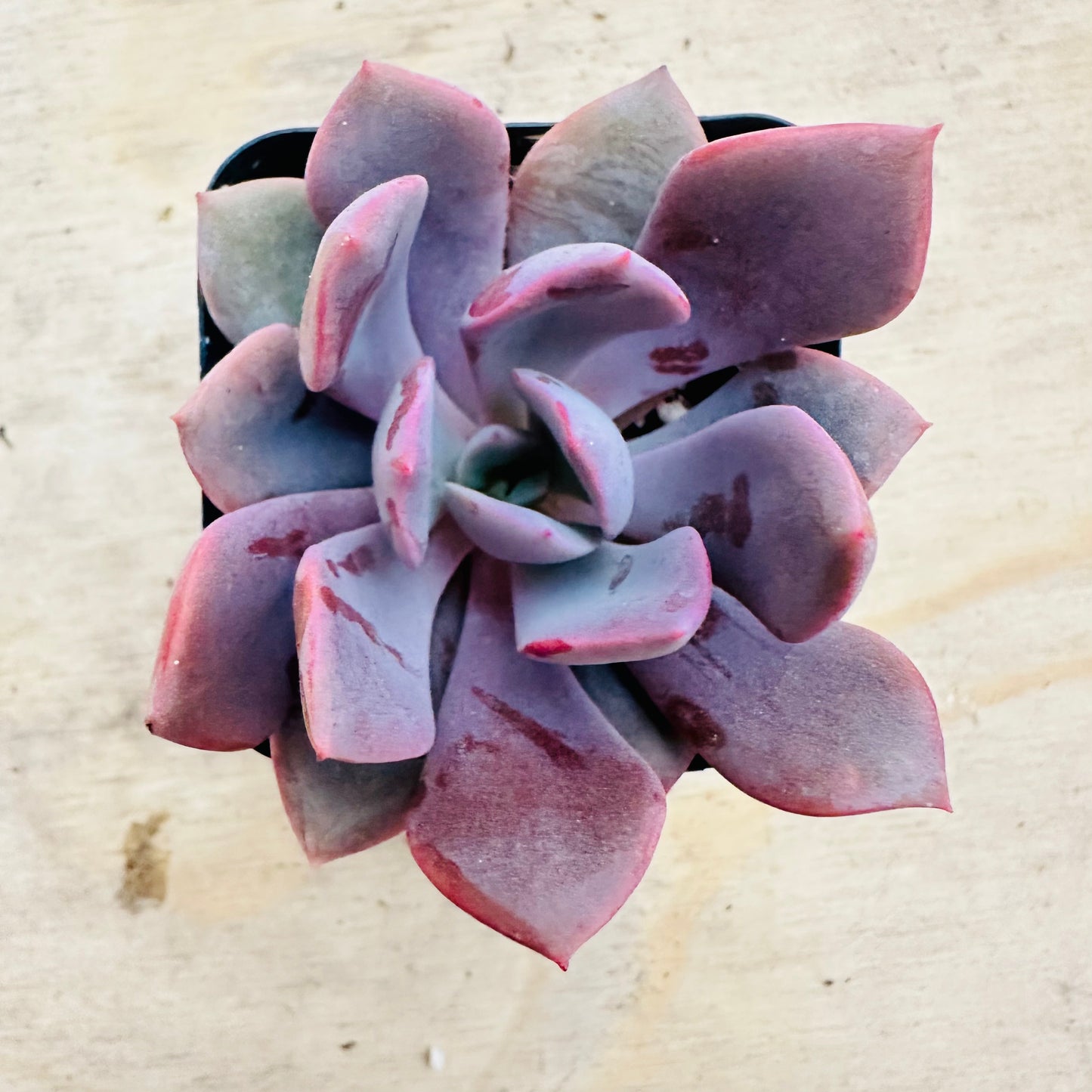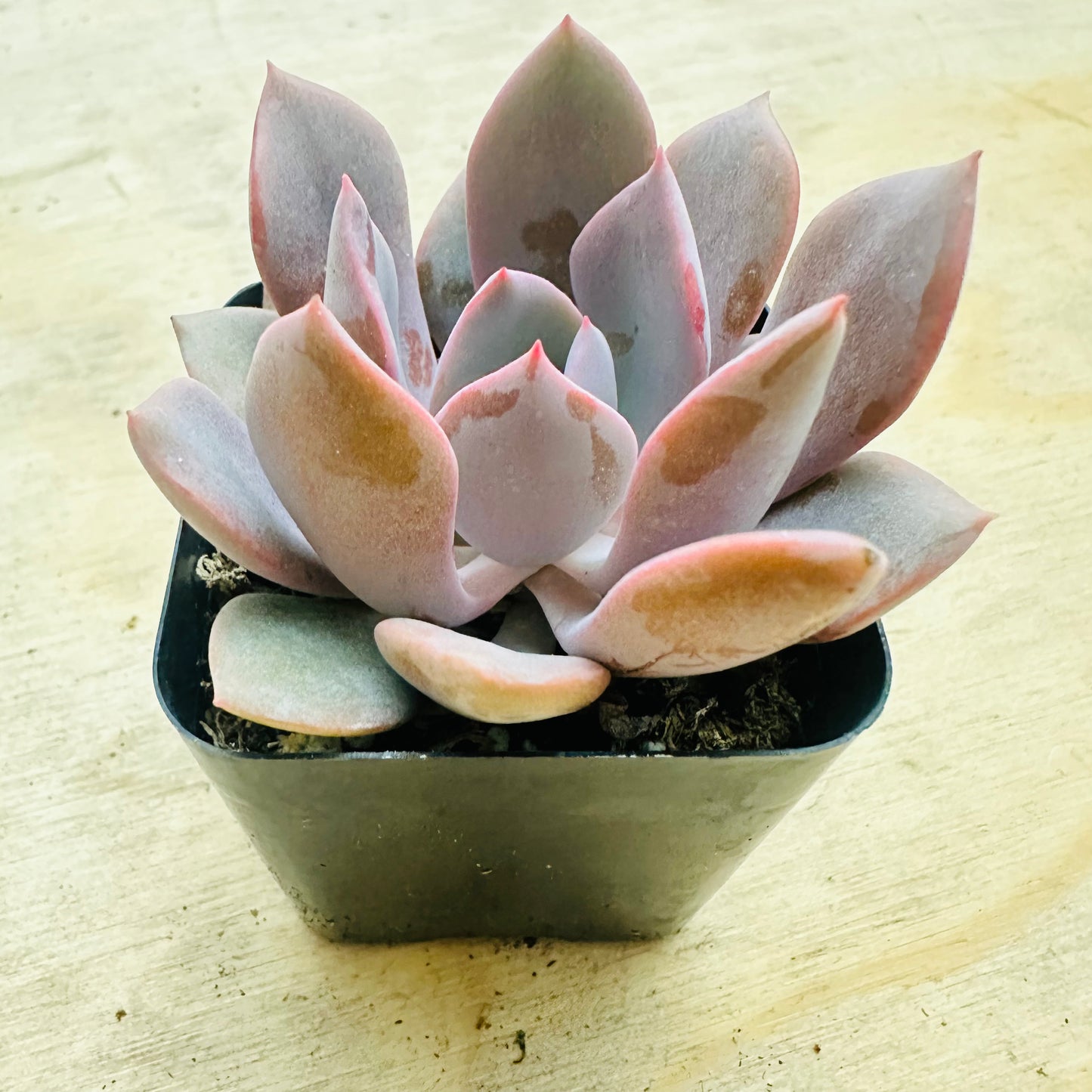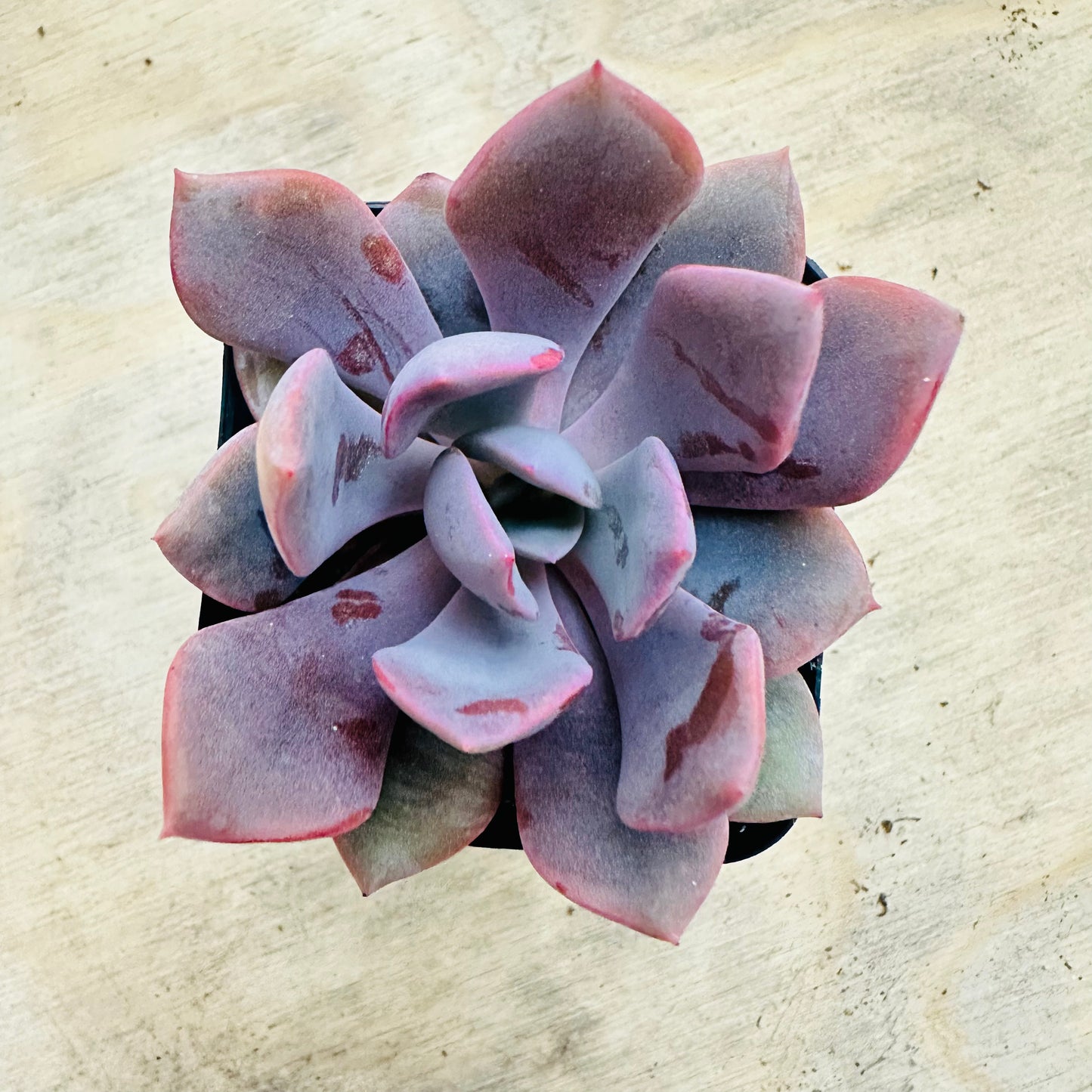Graptoveria - Debbie
Graptoveria - Debbie
In stock
Couldn't load pickup availability
📝 Description
Morphological Characteristics
Graptoveria ‘Debbie’ is a beautiful hybrid succulent, believed to be a cross between Graptopetalum amethystinum and Echeveria species, making it part of the Crassulaceae family. It’s prized for its elegant rosettes and striking pastel coloration.
This succulent forms tight, symmetrical rosettes of fleshy, spatula-shaped leaves that range in color from lavender-pink to pale blue, often with a dusty coating of farina (a powdery wax) that gives it a soft, pastel look. Under bright light or cool temperatures, the leaves develop deeper rose to peach-pink tones, especially at the tips.
Each rosette typically measures 10–15 cm (4–6 inches) in diameter and grows on short stems. Over time, Graptoveria ‘Debbie’ may form clumps of offsets around the base. In spring, it produces small, star-shaped orange or coral flowers on arching bloom stalks that rise above the foliage.
Growth Habits
Graptoveria ‘Debbie’ is a moderate-growing rosette succulent that stays relatively low and compact, reaching about 15–20 cm (6–8 inches) in height. It spreads slowly via basal offsets, making it excellent for container gardens, succulent arrangements, or low-water landscapes.
Maintenance Points
• Lighting: Requires bright, indirect light to full sun. Full sun enhances color and keeps the plant compact. Indoors, place near a south- or west-facing window.
• Watering: Water deeply only when the soil is completely dry. Avoid water sitting in the center of the rosette. Reduce watering in winter.
• Soil: Use a well-draining cactus or succulent soil mix. Add pumice, perlite, or coarse sand for improved drainage.
• Temperature: Ideal temperatures range between 18–27°C (65–80°F). Can tolerate brief drops to -1°C (30°F) if dry, but prolonged frost should be avoided.
• Fertilization: Apply a diluted succulent fertilizer once a month during spring and summer. No fertilizer is needed in winter.
• Potting: Use shallow pots with drainage holes. Repot every 2–3 years or when the plant becomes root-bound.
• Humidity: Prefers dry air and good airflow. Avoid misting, as moisture can damage the farina and encourage rot.
Reproduction Method
1. Offsets (Pups):
• Remove offsets when they are a few centimeters wide and have developed roots.
• Allow cut surfaces to callus for 1–2 days before planting.
• Place in well-draining soil and water lightly until established.
2. Leaf Cuttings:
• Gently twist off a healthy leaf, ensuring the base is intact.
• Let it dry and callus for several days, then place on soil.
• Mist lightly until roots and a new rosette begin to grow.
3. Seeds:
• Rarely used for this hybrid, but can be started with standard succulent germination care.
Additional Tips
• Pest Control: Watch for mealybugs and aphids, particularly at the leaf bases. Treat with neem oil or insecticidal soap as needed.
• Disease Prevention: Ensure excellent drainage and avoid water pooling in the rosette center.
• Pruning: Remove old flower stalks and dried lower leaves to keep the plant looking clean and healthy.
• Display: Works well in decorative pots, pastel-themed arrangements, or fairy gardens. Pairs beautifully with trailing succulents or contrasting dark-leaved varieties.
• Safety Note: Non-toxic to humans and pets. Handle gently to preserve the delicate farina coating.
With its soft pastel colors, rose-like form, and easy-care nature, Graptoveria ‘Debbie’ is a standout choice for both beginners and experienced succulent collectors—bringing elegance and charm to any indoor or outdoor garden.
🌿 Care Tips
Plant Care
Light
Water
Soil
Temperature
Hardiness
Fertilizer
Propagation: Leaf/offset cuttings
Common issues: Etiolation, mealybugs, rot
🌟 Note: It’s normal for succulents to appear slightly shriveled after shipping. They usually recover within a few days in a suitable environment.
📦 Shipping Info
Seah Shipping Policy
Effective Date: November 2025
This Shipping Policy applies to orders delivered within the continental United States (the lower 48 states). By purchasing from Seah, you agree to the terms below.
1) Shipping Cost & Free Shipping
- Automatic rate calculation: Shipping is calculated at checkout based on weight, destination ZIP and carrier rates.
- Free Standard Shipping: Orders $59+ (pre-tax, after discounts) ship free to the lower 48 states.
- Alaska, Hawaii, Puerto Rico & other territories: Not eligible for free shipping or standard flat offers at this time.
- Taxes/Duties: Applicable sales tax and any fees are shown at checkout.
2) Processing Schedule
- Business days only: We process and ship Monday–Friday. No shipping on weekends or U.S. federal holidays.
- Handling time: 1–3 business days after payment confirmation.
- Cut-off time: Orders placed before 3:00 PM (PST) are prioritized for same-day processing; others roll to the next business day.
- Changes/Cancellations: Email support@seah.co within 12 hours of purchase; after that, the order may already be in processing.
3) Transit Times
| Method | Estimated Transit | Total ETA (Handling + Transit) |
|---|---|---|
| Standard | 5–8 business days | 6–11 business days |
| Express | 3–4 business days | 4–7 business days |
ETAs are estimates. Weather, holidays, carrier delays or high-volume periods may extend delivery times.
4) Seasonal Temperature & Plant Safety
- Winter (Nov–Mar): We strongly recommend adding a heat pack at checkout to protect plants from freezing. Orders shipped without a heat pack during cold conditions are not covered for cold damage.
- Summer heat: During extreme heat waves, we may hold shipments until temperatures normalize. We’ll notify you if there’s a hold.
- Packaging: Plants are carefully packed (bare-root or potted by type/size) to minimize transit stress.
5) Carriers & Tracking
- We ship via USPS / UPS / FedEx, selected automatically for best service to your address.
- When your order ships, you’ll receive a tracking email. Tracking typically activates within 24 hours.
- If you haven’t received tracking within 3 business days, contact us at support@seah.co or +1 (626)-999-1314.
6) Address Changes & Delivery Issues
- Before shipment: Request address changes within 12 hours of ordering.
- After shipment: We can’t modify the address once dispatched. Please contact the carrier for redirection options.
- PO Boxes: Supported for USPS only; UPS/FedEx require a street address.
- Seah isn’t responsible for delays or loss due to incorrect addresses provided at checkout.
7) Service Area
We currently ship to the continental U.S. (lower 48 states). Orders to AK/HI/PR and other territories are not eligible for free shipping and may be restricted.
8) Support
- Hours: Mon–Fri, 9:00 AM – 5:00 PM (PST)
- Phone: +1 (626)-999-1314
- Email: support@seah.co
- Address: 7870 Margaux Pl, Rancho Cucamonga, CA 91739, United States
Thank you for supporting our California nursery—each plant is hand-selected and packed with care. 🌱








